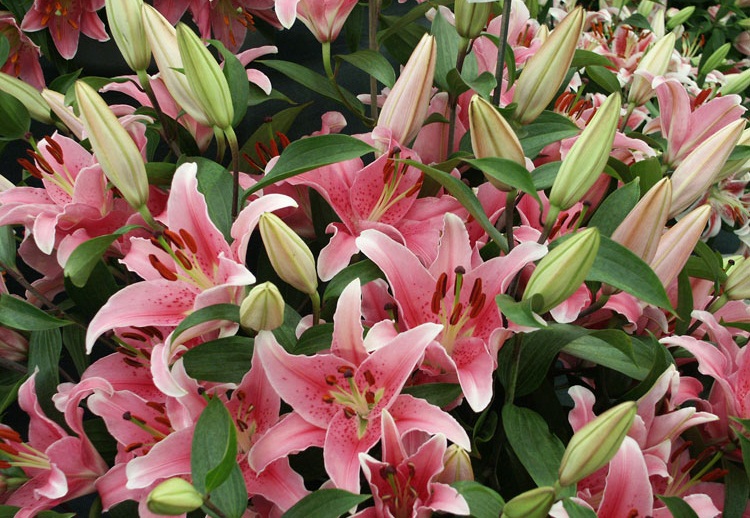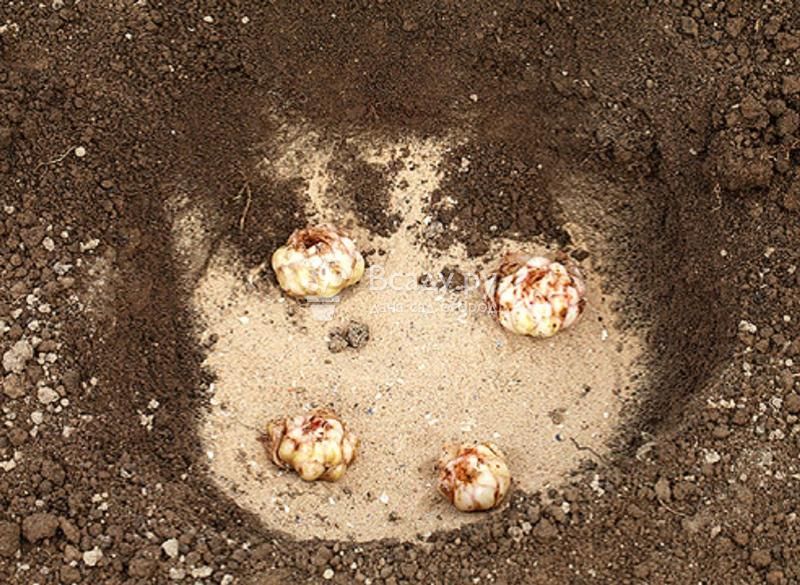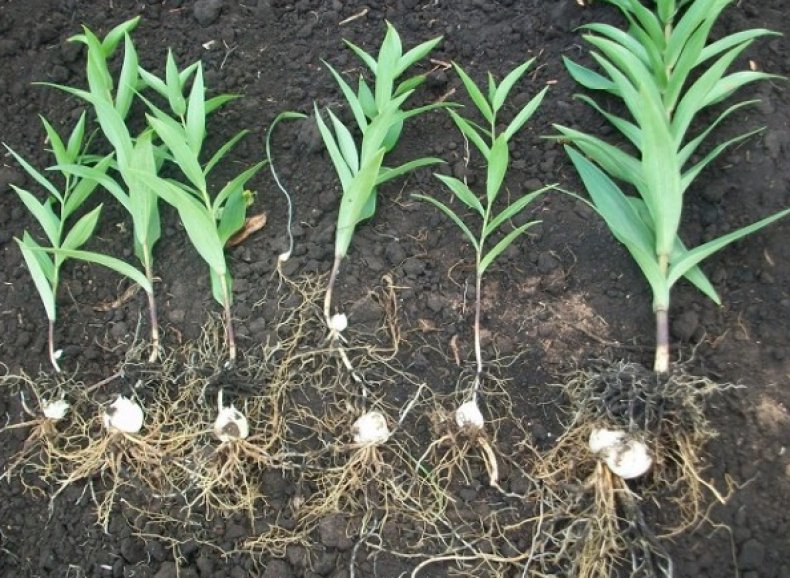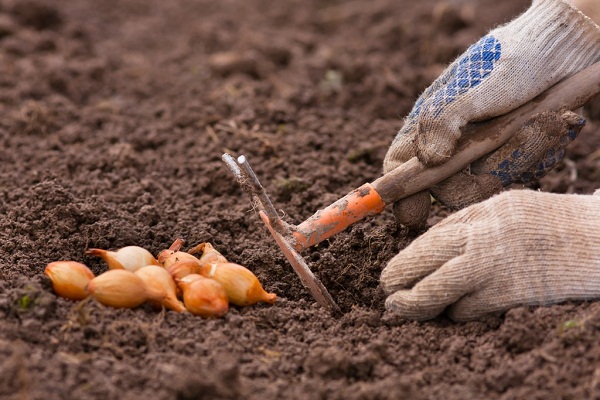Content:
Many gardeners ask questions about how to plant lilies and when to get an effective result. Each plant variety has its own characteristics of reproduction and further care. It is important to learn all the nuances of planting lilies in order to get a beautiful and lush garden over time.
In the process of growing the bulb, daughter bulbs (babies) appear on it, which must be separated in a timely manner for the development of large and strong inflorescences. For some species, bulb growth is characteristic for 10 years. In most varieties, the bulb grows from 3 to 4 years. Then it should be repotted and the daughter bulbs should be separated.
This is due to several reasons:
- the soil is depleted over time, which leads to a weakening of the flower and the formation of small inflorescences;
- children appearing on the bulb interfere with the full development of each other;
- lack of space for breeding new babies;
- infection with various diseases and the appearance of pests.
How often to plant lilies?
When to plant lilies is determined taking into account the variety:
- for fast-growing varieties - Candidum, tubular varieties, Asian hybrids - planting is recommended for 2-3 years;
- varieties characterized by a slow growth of the bulb, American hybrids and Martagon do not need to be planted earlier than 10 years.
When is the best time to plant lilies: spring, summer or autumn
Disputes between flower growers about when to plant lilies are ongoing. The main advantages of the autumn planting of lilies:
- Most cultivars fade towards the end of summer, after which the plant bulbs go into dormancy. In this state, the plant survives the transplant much easier.
- The period from autumn to spring is sufficient time for the bulbs to take root. The next year, the plant will give a more luxuriant color.
- By the next autumn, the nest will grow with a large number of daughter bulbs.
That is why most gardeners still prefer the autumn plant transplant.
Spring
For various reasons, gardeners start planting lilies in the spring. You can start transplanting flowers in the spring, but it is extremely important to choose the optimal month for this event. The region of residence and the climate in this case are of key importance.
Optimal months for different regions:
- for the southern regions, the end of April is approaching;
- middle zone of Russia - early May;
- Siberia and the Urals - after mid-May.
If it nevertheless happened that the bulb of the plant drove out the stem with the bud, planting flowers should be postponed until autumn.
Summer
In summer, it is recommended to plant varieties that end in bloom in the middle of summer. These include Candidum and the Snow White Lily.These flowers have a dormant state in August, so you can safely start planting them without worrying about their condition after transplantation.
Fall
Autumn is considered the best time to plant lilies. When starting to transplant a plant at this time, it is necessary to take into account the climatic conditions and characteristics of the variety.
Optimal seating time depending on the region:
- Leningrad Region - end of September;
- Central Russia - early October;
- Southern regions - late October and early November;
- Siberia and the Urals - all September.
Optimal months for seating, depending on the species:
- Royal Lilies, Candidum and Snow White varieties - September;
- Tubular varieties and oriental hybrids - October;
- Asiatic lilies - all year round.
How to plant lilies correctly
Soil preparation
First of all, you need to decide on a new place for lilies. A windless place with plenty of sunlight is best for the plant. If planted in a dark place, the plant will be less vibrant.
If you cannot allocate a new place, you can plant flowers in the same place where they grew. In this case, it is necessary to understand that the risk of contracting diseases significantly increases. To reduce the threat, experts recommend replacing the topsoil.
The next important factor is soil and soil. Bulbous plants do not tolerate stagnant water, the soil for them needs a waterproof one. Plants should be provided with good drainage with a thickness of 5-6 centimeters. In order to prevent oversaturation of the soil with moisture, you can make small drainage grooves in which rain and melt water will accumulate.
The flower primer should be neutral in acidity and high in nutrients. You can fill the soil with nutrients by adding peat or humus to it in half with leafy soil. Superphosphate can serve as a mineral fertilizer.
Preparation of planting material
- First you need to remove all the stems above the soil level.
- Use a fork to dig out the bulbs of the plant. You can use a shovel, but in this case there is a risk of damage to the planting material. Gently peel the soil off the bulb.
- Carefully separate the daughter bulbs from the main nest.
- Next, you need to remove the stem, and then separate all damaged and dead scales.
- Trim off any broken roots. Leave about 15 centimeters of healthy roots.
- Next, you need to disinfect the dug out bulbs. If there is a manganese solution in the house, you need to keep the planting material in it for 15 minutes. If there is no manganese, you can replace it with karbofos, while increasing the holding time to 20-30 minutes. It is necessary to apply in the proportion - 1 teaspoon per 5 liters of water.
Planting bulbs step by step
The planting depth of the bulb depends on its size and plant variety. The larger the bulb, the deeper you need to immerse it in the hole.
The distance between the plant bulbs also depends on the variety. The taller the flowers, the farther apart the lilies are planted.
Determining the distance between bulbs:
- For undersized varieties - 15-20 centimeters;
- For medium-sized varieties - 20-25 centimeters;
- For tall varieties - 25-30 centimeters.
When the depth and distance between the holes are determined, it is necessary to start drainage. To do this, you need to pour a small amount of sand on the bottom of the hole and install the onion on the drain, carefully straightening its roots.Further, you need to sprinkle the onion with nutritious soil and water abundantly, thereby filling all the voids. The last step will be to cover the soil with peat in order to protect the root system of the future plant.
Expert advice
- In spring, experts recommend planting flowers by dividing the bush. To do this, you need to dig out a bush and separate the daughter bulbs from the nest. At the same time, you do not need to shake off the earth from the bulbs - this way the plant will take root more easily. In this case, the distance between the planting holes should be 15-20 cm. Then each bulb with a stem should be planted at the same depth at which they were before digging.
- Experts give advice on how to plant lilies in the fall so they don't die from frost. After planting, the plants must be insulated for the winter. Sawdust or dry leaves are suitable as insulation. The optimum layer thickness is 15 cm. Old boards or plastic wrap are applied on top.
- The lily needs to be watered often, but with a little water. The flower can tolerate a slight drought, while overflow can rot it.
- These flowers cannot tolerate organic fertilizers in their pure form. Better to use mineral fertilizers.
At first glance, planting lilies can seem daunting. But if you study all the features, follow the recommendations and properly care for the plant, then beautiful and lush lilies will surely begin to bloom in every garden!















